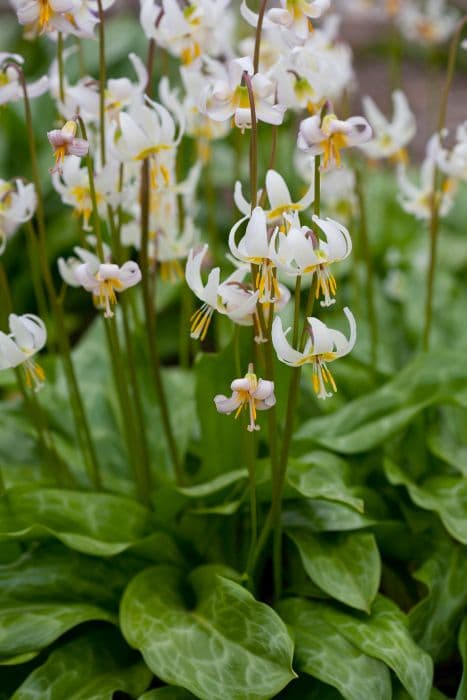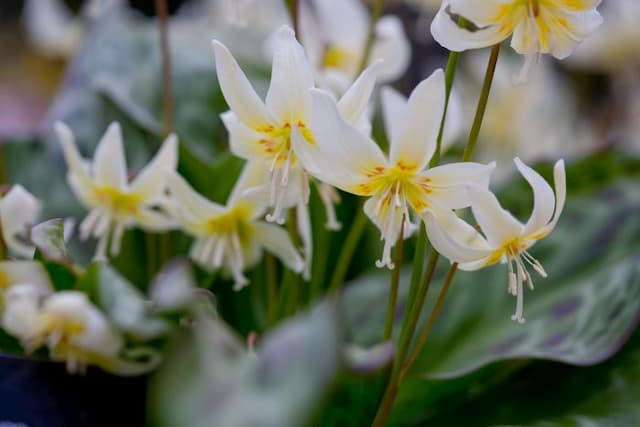Tulip Tulipa 'Honeymoon' (7)

ABOUT
The Tulip 'Honeymoon' is an exquisite variety known for its unique and elegant blooms. The flowers exhibit a stunning, creamy white color that can appear almost translucent, giving a delicate and ethereal look. The petals have a distinctive cup shape that is characteristic of tulips, with a graceful form that tapers to a point at the tips, lending an overall sophisticated silhouette to the flower. As the flower matures, the outer petals may gently curve outward, which can reveal a slight hint of green or yellow at their bases, providing a soft contrast to the creamy white. The interior of the bloom often features a deeper yellow coloration around the stamens and pistil, which can draw the eye into the heart of the flower. The leaves of the 'Honeymoon' tulip are equally striking, being a deep, rich green. They typically grow in a dense clump, providing a lush backdrop that highlights the beauty of the blooms. Their texture is somewhat waxy and glossy, enhancing the visual appeal with a subtle sheen. Overall, the Tulip 'Honeymoon' is a breathtaking plant, celebrated for its romantic and dreamy flowers that can add a touch of elegance to any garden or floral arrangement.
About this plant
 Names
NamesSynonyms
Honeymoon Tulip
Common names
Tulipa 'Honeymoon'
 Toxicity
ToxicityTo humans
Tulips are generally considered to have a low level of toxicity for humans. Ingesting parts of the tulip can cause irritation to the mouth and digestive system, leading to symptoms that may include nausea, vomiting, and diarrhea. In most cases, the consumption of tulip bulbs or other plant parts in small quantities would likely result in mild gastrointestinal upset. However, significant ingestion, especially of the bulbs, could potentially lead to more severe symptoms and should be avoided.
To pets
Tulips can be toxic to pets, particularly dogs and cats. The plant contains compounds that can irritate the mouth and gastrointestinal tract if ingested. Symptoms of tulip poisoning in pets might include drooling, vomiting, diarrhea, and possibly depression. The bulb contains the highest concentration of these irritating compounds, so ingestion of the bulb is particularly concerning and can lead to more severe symptoms. If a pet consumes a tulip plant or bulb, it is advisable to consult a veterinarian.
 Characteristics
CharacteristicsLife cycle
Perennials
Foliage type
Deciduous
Color of leaves
Green
Flower color
White
Height
1 foot 6 inches (45.72 cm)
Spread
6 inches (15.24 cm)
Plant type
Bulb
Hardiness zones
3
Native area
Central Asia
Benefits
 General Benefits
General Benefits- Enhances Landscape Aesthetics: Tulipa 'Honeymoon' displays stunning white flowers that can significantly improve the visual appeal of gardens and landscapes.
- Attracts Pollinators: The blooms are attractive to bees and other pollinating insects, which are essential for the environment and the health of many other plant species.
- Easy to Grow: Tulips are known for being low-maintenance, making them a great choice for gardeners of all skill levels.
- Spring Color: Tulips bloom in the spring, providing early color to gardens that have been dormant through the winter.
- Bulb Perenniality: As a bulbous plant, Tulipa 'Honeymoon' can return for several seasons, provided the bulbs are cared for properly.
- Versatile Planting Options: Tulips can be planted in beds, borders, containers, and even used for cut flowers indoors.
- Symbolic Flower: Tulips are associated with different meanings, including perfect love and happiness, which makes them a popular choice for special occasions and gifts.
 Medical Properties
Medical PropertiesThis plant is not used for medical purposes.
 Air-purifying Qualities
Air-purifying QualitiesThis plant is not specifically known for air purifying qualities.
 Other Uses
Other Uses- Tulip petals are edible and can be used in salads for a colorful addition or as a garnish on dishes to provide an elegant touch to the culinary presentation.
- The sturdy stems of tulips can be used in floral crafts, such as making homemade wreaths or adding structural interest to mixed media art projects.
- Collected tulip bulbs can be used in science classrooms for dissecting and studying plant biology and reproductive systems.
- Pulverized dried tulip petals can be used as a natural dye for fabrics or paper, providing a range of colors from soft yellows to vibrant pinks depending on the variety.
- Tulip flowers can be crystallized with sugar and used to decorate cakes or desserts, giving them an exquisite and unique appearance.
- The strong geometric shapes of tulip flowers can serve as inspiration for designers and architects, influencing patterns, textiles, or building concepts.
- Tulip petals can be infused in oils to create naturally scented oils for use in aromatherapy or as a fragrant addition to homemade candles or soaps.
- Tulips can be used in photography as a subject for macro photography practice, showcasing the intricate patterns and textures of the flower.
- Dried tulip petals can be included in homemade potpourri mixes, adding color and a subtle fragrance to the mixture.
- During tulip festivals, these flowers are often used to create large, intricate floral mosaics and displays that attract tourists and promote local culture and history.
Interesting Facts
 Feng Shui
Feng ShuiThe tulip is not used in Feng Shui practice.
 Zodiac Sign Compitability
Zodiac Sign CompitabilityThe tulip is not used in astrology practice.
 Plant Symbolism
Plant Symbolism- Perfect Love: The Tulip 'Honeymoon' often represents perfect and deep love, reminiscent of the love within a honeymoon phase.
- Eternal Bonds: This specific variety might symbolize the everlasting connections between two people, as a honeymoon is the celebratory beginning of a lifelong journey together.
- New Beginnings: Honeymoon tulips can indicate fresh starts or new chapters, much like the start of a marriage.
- Happiness: The bright and cheerful bloom is also associated with happiness, just as a honeymoon is a joyful time for couples.
- Fertility: Tulips in general can represent abundance and fertility, which could be tied to the hope for a growing family following a wedding.
- Hope and Aspiration: As a new marriage marks hopes for the future, so too does this plant convey optimism for what lies ahead.
- Rare Beauty: The Tulip 'Honeymoon', as a cultivated variety, may symbolize unique and rare beauty, celebrating the special quality of a new marital union.
 Water
WaterTulips require moderate watering, and it's essential not to overwater them as this can lead to bulb rot. During the growing season, water your 'Honeymoon' tulips once a week with about a half gallon of water per square foot, ensuring the soil is moist but not waterlogged. During the dormant season, after the foliage has died back, you should reduce watering to help the bulbs rest. In periods of rain, adjust your watering accordingly to account for natural precipitation. Always check the soil moisture before watering to prevent over-saturation.
 Light
Light'Honeymoon' tulips thrive in full sun to partial shade. They perform best when they receive at least 6 hours of direct sunlight daily. An ideal spot would be one that gets the gentle morning sun but is shaded from the intense afternoon heat. These lighting conditions will help produce vibrant blooms and strong stems.
 Temperature
TemperatureTulips prefer cooler climates and can generally survive winter temperatures as low as 20 degrees Fahrenheit. The 'Honeymoon' variety, like other tulips, does well in a temperature range around 60 to 70 degrees Fahrenheit during their growing season. They are spring-blooming bulbs, so they require a period of winter chilling at temperatures between 35 and 55 degrees Fahrenheit to thrive and bloom in the spring.
 Pruning
PruningPruning tulips involves deadheading spent flowers shortly after they fade to redirect energy to the bulb rather than seed production. 'Honeymoon' tulips should be pruned once the blooms have withered, typically late spring. Leave the foliage in place until it turns yellow and dies back naturally, as this allows the plant to gather nutrients for the next growing season.
 Cleaning
CleaningAs needed
 Soil
SoilThe best soil mix for Tulips, the common name for Tulipa 'Honeymoon', is well-draining sandy loam enriched with organic matter. The ideal soil pH should be between 6.0 and 7.0. To prepare the mix, combine two parts garden soil, one part well-rotted compost or aged manure, and one part sharp sand or perlite.
 Repotting
RepottingTulips generally do not require frequent repotting; they are usually planted as bulbs once a year in the fall and then removed and stored after the foliage dies back in late spring to early summer.
 Humidity & Misting
Humidity & MistingTulips prefer outdoor conditions with natural ambient humidity. They do not require high humidity and do best in well-ventilated areas that mimic their natural environment. Specific humidity levels are not usually necessary for tulips.
 Suitable locations
Suitable locationsIndoor
Grow Tulips indoors in bright, indirect light with cool temperatures.
Outdoor
Plant Tulip bulbs outdoor in fall in well-draining soil with full sun.
Hardiness zone
3-8 USDA.
 Life cycle
Life cycleTulipa 'Honeymoon', commonly known as the Honeymoon Tulip, begins its life cycle as a bulb, which is planted in well-drained soil in the fall before the first frost. The bulb goes through a period of dormancy over winter, which is broken by vernalization (exposure to cold temperatures), a crucial process that triggers spring growth. As temperatures warm in the spring, the bulb sprouts foliage and a stem, which precedes the development of the tulip's distinctive flower. After flowering, typically in late spring, the bloom dies back, and the plant goes through a period of energy accumulation where the leaves photosynthesize to store energy back into the bulb for the next season. Once the foliage has yellowed and died back, usually by early summer, the bulb returns to a period of dormancy. The cycle repeats the following year when the bulb is triggered to regrow by the changing temperatures.
 Propogation
PropogationPropogation time
Spring
The most popular method of propagating Tulipa 'Honeymoon', also commonly known as the Honeymoon tulip, is through bulb division. This procedure is commonly performed at the end of the flowering season, usually in late spring to summer, after the foliage has died back. Gardeners dig up the bulbs, carefully clean them of soil, and then remove any offsets or smaller bulbs that have formed around the base of the parent bulb. These offsets can be replanted immediately if the ground isn't frozen or excessively wet; otherwise, they can be stored in a cool, dry place until the appropriate planting time in the fall. The depth at which bulbs are planted is crucial; typically, they are situated about 6 to 8 inches (15 to 20 centimeters) deep, with the pointed end upwards and spaced approximately 4 to 6 inches (10 to 15 centimeters) apart to ensure ample room for growth.









